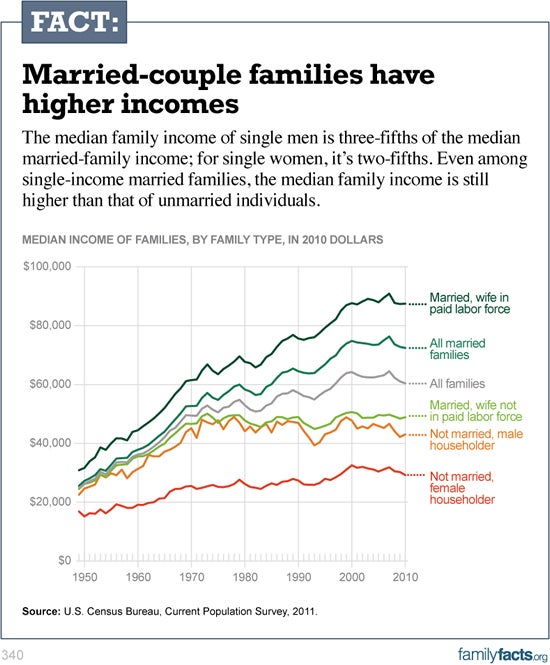While economic disparities between rich and poor are vehemently decried in stump speeches and the main stream media, value differences are often considered as a third-rail issue to be avoided in public discussion. In typical fashion, Charles Murray broaches this subject head-on in his newly released book Coming Apart, which documents a cultural drift and widening gap between an upper class and a lower class in white America. Those concerned about income inequality should take notice, because research has found that values and the behavior they promote are closely linked to economic well-being.
As Murray notes, though marriage rates fell within wealthy and low-income white Americans from 1960 to 1970, they have stabilized at just above 80 percent among the upper class since the mid-1980s, but they continued to plummet among the lower class. In 2010, within that sector of America just 48 percent were married. A similar gap also exists today regarding the number of births outside of marriage in both classes: Extra-marital births account for less than 6 percent of all births among women with a college education but an ominous 44 percent among those with only a high school education.
Numerous studies presented in Heritage’s FamilyFacts.org have shown that marital status, particularly that of mothers, is linked to financial well-being. Married women are less likely to experience poverty, and unmarried mothers face a greater risk of welfare dependency. In fact, marriage reduces the probability that a child will be in poverty by 82 percent. Marriage brings a likelihood of greater financial success for men as well. Married men tend to have greater earnings than those in cohabiting relationships, and married individuals are more likely to own a home, accumulate savings, and attain affluence.
Murray also cites the religious aspect of the cultural drift in America: While 40 percent of wealthy white Americans are categorized as “secular” (i.e., they profess no religion or attend worship services less than once a year), nearly 60 percent of the lower-income individuals fall into this category. Research has revealed a link between religiosity and the likelihood of marrying, marital stability, and marital satisfaction and happiness—all of which are ultimately linked to both income disparity and the growing gap between the level of happiness reported by the two classes.
Our nation’s policymakers should not view the widening cultural gap that Murray documents as an unavoidable doomsday scenario. Rather, they should view it as a clarion call regarding the critical importance of designing policy that promotes strong and healthy marriages and ensures that Americans maintain the freedom to practice their faith and embody their religious values in their daily lives.




























